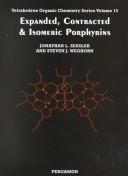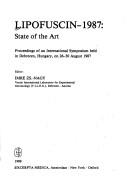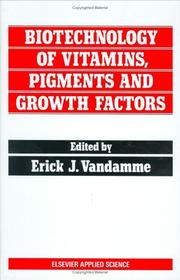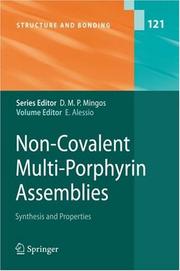| Listing 1 - 10 of 12 | << page >> |
Sort by
|
Book
ISBN: 9811614903 981161489X Year: 2021 Publisher: Gateway East, Singapore : Springer,
Abstract | Keywords | Export | Availability | Bookmark
 Loading...
Loading...Choose an application
- Reference Manager
- EndNote
- RefWorks (Direct export to RefWorks)
Pigments (Biology) --- Biochromes --- Biological pigments --- Pigment cells --- Biochemistry --- Pigments --- Pigments (Biologia) --- Bioquímica --- Carotenoides

ISBN: 9780080420929 0080420923 9780080535234 0080535232 1281058645 9781281058645 9786611058647 0080420931 Year: 1997 Publisher: Oxford, U.K. New York, NY Pergamon
Abstract | Keywords | Export | Availability | Bookmark
 Loading...
Loading...Choose an application
- Reference Manager
- EndNote
- RefWorks (Direct export to RefWorks)
The porphyrins are a class of naturally-occurring macrocycles and are ubiquitous in our world. As such, they have been called the Pigments of Life. This auspicious designation reflects their importance in numerous biological functions. Indeed, life as we understand it relies on the full range of biological processes that are either performed by or catalyzed by porphyrin-containing proteins. Chlorophyll-containing photosynthetic reaction centers in plants, for instance, convert light energy into chemical energy while producing oxygen along the way. It is this oxygen, evolved from photosynthesis
Porphyrins. --- Porphyrins --- Isomerism. --- Pigments (Biology) --- Biochromes --- Biological pigments --- Pigment cells --- Biochemistry --- Pigments --- Chemistry, Physical and theoretical --- Molecular rotation --- Stereochemistry --- Porphyrin and porphyrin compounds --- Macrocyclic compounds --- Synthesis.
Book
ISBN: 1461443555 1461443547 Year: 2014 Publisher: New York, NY : Springer US : Imprint: Springer,
Abstract | Keywords | Export | Availability | Bookmark
 Loading...
Loading...Choose an application
- Reference Manager
- EndNote
- RefWorks (Direct export to RefWorks)
Photopigments are molecules that react to light and mediate a number of processes and behaviours in animals. Visual pigments housed within the photoreceptors of the eye, such as the rods and cones in vertebrates are the best known, however, visual pigments are increasingly being found in other tissues, including other retinal cells, the skin and the brain. Other closely related molecules from the G protein family, such as melanopsin mediate light driven processes including circadian rhythmicity and pupil constriction. This Volume examines the enormous diversity of visual pigments and traces the evolution of these G protein coupled receptors in both invertebrates and vertebrates in the context of the visual and non-visual demands dictated by a species’ ecological niche.
Pigments (Biology) --- Biochromes --- Biological pigments --- Pigment cells --- Biochemistry --- Pigments --- Neurosciences. --- Ophthalmology. --- Cytology. --- Cell Biology. --- Cell biology --- Cellular biology --- Biology --- Cells --- Cytologists --- Medicine --- Eye --- Neural sciences --- Neurological sciences --- Neuroscience --- Medical sciences --- Nervous system --- Diseases --- Cell biology.

ISBN: 0444809562 Year: 1988 Volume: vol 782 Publisher: Amsterdam New York Oxford Excerpta Medica
Abstract | Keywords | Export | Availability | Bookmark
 Loading...
Loading...Choose an application
- Reference Manager
- EndNote
- RefWorks (Direct export to RefWorks)
Aging --- Pigments, Biological --- Lipofuscin. --- Aging. --- Pigments, Biological. --- -Lipofuscins --- -Aging pigments --- Lipofuscin --- Animal pigments --- Lipids --- Age --- Ageing --- Senescence --- Developmental biology --- Gerontology --- Longevity --- Age factors in disease --- Biological Pigments --- Coloring Agents --- Aging, Biological --- Biological Aging --- Mutation Accumulation --- physiology. --- metabolism. --- Physiological aspects --- -Congresses --- Congresses --- Physiological effect --- Lipofuscins --- Pigments --- Congresses. --- physiology --- congresses. --- metabolism --- -physiology. --- Aging pigments --- Physiological aspects&delete& --- Physiology --- Metabolism
Book
ISBN: 0122899016 0122899024 Year: 1976 Publisher: London : Academic press,
Abstract | Keywords | Export | Availability | Bookmark
 Loading...
Loading...Choose an application
- Reference Manager
- EndNote
- RefWorks (Direct export to RefWorks)
Plant pigments --- Botanical chemistry --- Pigments végétaux --- Chimie végétale --- Pigments, Biological --- Pigments --- 581.1 --- Paint materials --- Coloring matter --- Paint --- Plants --- Phytochemicals --- Pigments (Biology) --- Chromatophores --- Plastids --- Phytochemistry --- Plant biochemistry --- Plant chemistry --- Biochemistry --- Botany --- Plant biochemical genetics --- analysis. --- Plant physiology --- Color --- Pigments, Biological. --- Biological Pigments --- Coloring Agents --- Botanical chemistry. --- Plant pigments. --- 581.1 Plant physiology --- Pigments végétaux --- Chimie végétale --- analysis
Book
ISBN: 3764374993 3764374985 Year: 2007 Publisher: Basel : London : Birkhauser ; Springer [distributor],
Abstract | Keywords | Export | Availability | Bookmark
 Loading...
Loading...Choose an application
- Reference Manager
- EndNote
- RefWorks (Direct export to RefWorks)
The Carotenoids book series provides detailed accounts of the fundamental chemistry of carotenoids and the basic methods used in carotenoid research, and critical discussions of the biochemistry, functions and applications of these important compounds. Volume 4 and its companion, Volume 5, deal with the functions of carotenoids in all kinds of living organisms and the actions of carotenoids in human nutrition and health. The material presented in the earlier Volumes is all relevant to studies of biological functions and actions. In particular, biological studies must be supported by a rigorous analytical base. The various analytical procedures described in Volumes 1A and 1B, supplemented by the data for individual compounds given in the Carotenoids Handbook, must be understood and applied correctly, whether they are being used for quantitative analysis, identification or in complex studies of carotenoids in situ. In the first part of Volume 4, the structural features that are most important for determining the properties and hence the biological roles of carotenoids are emphasized. The overall molecular geometry (size, three-dimensional shape, presence of functional groups) is vital to ensure that the carotenoid fits into cellular, sub-cellular and molecular structures in the correct location and orientation to allow it to function efficiently. Specific interactions with other molecules, e.g. to form aggregates or complexes with proteins, strongly influence the properties of a carotenoid in vivo and are thus also crucial to functioning. The extended delocalized p-electron system that characterizes the central part of the structure gives the carotenoids their peculiar photochemical properties and reactivity towards oxidizing agents and free radicals. This treatment provides a foundation for the description of the main functions of carotenoids and their breakdown products in the second part of Volume 4 and in Volume 5. Topics covered in Volume 4 include various aspects of the roles of carotenoids in colour and colouration, photosynthesis and other photofunctions, and protection. The formation and roles of carotenoid metabolites and breakdown products as perfume/aroma compounds and as vitamin A are also outlined; the latter is dealt with in more detail in Volume 5, which provides a comprehensive discussion of carotenoids in human health and nutrition.. Biologists now are not only discovering new phenomena but are striving to elucidate details of the underlying mechanisms that explain their observations. Chemistry is moving in new directions relevant to studies in vivo and new techniques are being developed to investigate structural details and interactions and to detect and interpret changes on an ever shorter timescale. Volumes 4 and 5 thus point the way to the future of carotenoid research by highlighting the importance of interdisciplinary approaches to study these complex and sophisticated systems.
Carotenoids. --- Pigments (Biology) --- Biochromes --- Biological pigments --- Pigment cells --- Carotinoids --- Chromolipids --- Lipochromes --- Luteins --- Chemistry. --- Human physiology. --- Organic chemistry. --- Biochemistry. --- Plant biochemistry. --- Plant physiology. --- Chemistry/Food Science, general. --- Organic Chemistry. --- Human Physiology. --- Biochemistry, general. --- Plant Biochemistry. --- Plant Physiology. --- Biochemistry --- Pigments --- Terpenes --- Chemistry, Organic. --- Botany --- Plants --- Physiology --- Biological chemistry --- Chemical composition of organisms --- Organisms --- Physiological chemistry --- Biology --- Chemistry --- Medical sciences --- Human biology --- Human body --- Organic chemistry --- Physical sciences --- Composition --- Phytochemistry --- Plant biochemistry --- Plant chemistry --- Phytochemicals --- Plant biochemical genetics
Periodical
ISSN: 08935785 1755148X 16000749 17551471 Publisher: New York (N.Y.) : Liss,
Abstract | Keywords | Export | Availability | Bookmark
 Loading...
Loading...Choose an application
- Reference Manager
- EndNote
- RefWorks (Direct export to RefWorks)
Histology. Cytology --- Genetics --- Melanoma --- Pigmentation --- Chromatophores --- Animal pigments --- Pigments animaux --- periodicals. --- Periodicals. --- Périodiques --- Chemistry --- Biochemistry --- Chemical Engineering --- Dermatology --- General and Others --- Optics & Opto Electronics --- Engineering --- Health Sciences --- Life Sciences --- Physics --- Zoology --- Chemistry. --- Optics & Opto Electronics. --- Engineering. --- Health Sciences. --- Life Sciences. --- Physics. --- Animal pigments. --- Chromatophores. --- Cytologie. --- Pigment. --- Pigmentation. --- Mélanome --- Pigments (Biologie) --- Melanoma. --- Melanocytes. --- Pigmentations --- Pigments, Biological --- Malignant Melanoma --- Malignant Melanomas --- Melanoma, Malignant --- Melanomas --- Melanomas, Malignant --- Pigment cells --- Chloroplasts --- Epithelial cells --- Plant pigments --- Plastids --- Protoplasm --- Zoochromes --- Pigments (Biology) --- Animals --- Color --- Animal Behavior --- Mélanome. --- Malignant melanoma --- Melanocytic tumor --- Cancer --- Neuroendocrine tumors --- Biochromes --- Biological pigments --- Pigments
Book
ISBN: 3030509710 3030509702 Year: 2020 Publisher: Cham : Springer International Publishing : Imprint: Springer,
Abstract | Keywords | Export | Availability | Bookmark
 Loading...
Loading...Choose an application
- Reference Manager
- EndNote
- RefWorks (Direct export to RefWorks)
The Pigments from Microalgae Handbook presents the current state of knowledge on pigment production using microalgae-based processes, and covers both the scientific fundamentals of this technology and its practical applications. It addresses biology, chemistry, biochemistry, analysis and engineering aspects, as well as applications of natural pigments in photosynthetic organisms. The book also describes the analytical procedures associated with the characterization of pigments and the engineering aspects of microalgal pigment production. It considers the three major classes of pigments(chlorophylls, carotenoids and phycobiliproteins) produced and surveys the main commercial applications of these chemicals. The book offers a valuable source of information for industrial researchers and practitioners in industrial biotechnology, as it covers various engineering aspects of microalgal pigment production, such as bioreactors and bioprocesses, industrial extraction processes, and the bioeconomy of production including life-cycle assessment. The book will also be of interest to undergraduate and graduate students of biochemistry, food chemistry, and industrial microbiology.
Chemical engineering. --- Biochemical engineering. --- Biomedical engineering. --- Microbiology. --- Industrial engineering. --- Production engineering. --- Organic chemistry. --- Industrial Chemistry/Chemical Engineering. --- Biochemical Engineering. --- Biomedical Engineering/Biotechnology. --- Applied Microbiology. --- Industrial and Production Engineering. --- Organic Chemistry. --- Management engineering --- Simplification in industry --- Engineering --- Value analysis (Cost control) --- Chemistry, Industrial --- Engineering, Chemical --- Industrial chemistry --- Chemistry, Technical --- Metallurgy --- Manufacturing engineering --- Process engineering --- Industrial engineering --- Mechanical engineering --- Clinical engineering --- Medical engineering --- Bioengineering --- Biophysics --- Medicine --- Microbial biology --- Biology --- Microorganisms --- Organic chemistry --- Chemistry --- Bio-process engineering --- Bioprocess engineering --- Biochemistry --- Biotechnology --- Chemical engineering --- Pigments (Biology) --- Biochromes --- Biological pigments --- Pigment cells --- Pigments --- Chemistry, Organic.

ISBN: 1851663258 9401069913 9400911114 Year: 1989 Publisher: London ; New York : Elsevier Applied Science,
Abstract | Keywords | Export | Availability | Bookmark
 Loading...
Loading...Choose an application
- Reference Manager
- EndNote
- RefWorks (Direct export to RefWorks)
Biotechnology --- Growth Substances --- Pigments --- Vitamins --- Growth factors --- Pigments (Biology) --- Vitamines --- Facteurs de croissance --- Pigments (Biologie) --- Biotechnologie --- Biotechnology. --- Growth Substances. --- Pigments, Biological. --- Vitamins. --- 577.16 --- 547.97 --- 577.175 --- 66.098 --- -Pigments (Biology) --- -Vitamins --- -Nutrition --- Avitaminosis --- Cell growth factors --- Cellular growth factors --- Growth peptides --- Growth promoting substances --- Growth substances --- Peptide growth factors --- Peptide regulatory factors --- Polypeptide growth factors --- Cytokines --- Peptides --- Vitamin --- Biological Pigments --- Coloring Agents --- Mitogens, Endogenous --- Endogenous Mitogens --- Agricultural Inoculants --- Biotechnologies --- Vitamins. Vitamin-like substances. Vitaminology --- Classification of hormones --- Biological processes. Biotechnology --- Pigments. --- Basic Sciences. Microbiology --- Industrial Microbiology Industrile --- Industrial Microbiology Industrile. --- -Vitamins. Vitamin-like substances. Vitaminology --- 66.098 Biological processes. Biotechnology --- 577.175 Classification of hormones --- 547.97 Pigments --- 577.16 Vitamins. Vitamin-like substances. Vitaminology --- -66.098 Biological processes. Biotechnology --- Pigments, Biological --- Industrial Microbiology.

ISSN: 00815993 ISBN: 9783540325420 3540325425 3540325433 Year: 2006 Volume: 121 Publisher: Berlin, Heidelberg : Springer Berlin Heidelberg : Imprint: Springer,
Abstract | Keywords | Export | Availability | Bookmark
 Loading...
Loading...Choose an application
- Reference Manager
- EndNote
- RefWorks (Direct export to RefWorks)
Porphyrins --- Synthesis --- chemical synthesis --- Chemistry. --- Chemistry, inorganic. --- Chemistry, Organic. --- Chemistry, Physical organic. --- Inorganic Chemistry. --- Physical Chemistry. --- Organic Chemistry. --- Pigments, Biological --- Tetrapyrroles --- Heterocyclic Compounds with 4 or More Rings --- Pyrroles --- Macrocyclic Compounds --- Biological Factors --- Heterocyclic Compounds --- Chemicals and Drugs --- Polycyclic Compounds --- Azoles --- Heterocyclic Compounds, 1-Ring --- Animal Biochemistry --- Physical & Theoretical Chemistry --- Inorganic Chemistry --- Chemistry --- Human Anatomy & Physiology --- Health & Biological Sciences --- Physical Sciences & Mathematics --- Porphyrins. --- Synthesis. --- Heterocyclic Cpds, 1-Ring --- 1-Ring Heterocyclic Compounds --- 1-Ring Heterocyclic Cpds --- Heterocyclic Compounds, 1 Ring --- Heterocyclic Cpds, 1 Ring --- Compounds, Polycyclic --- Compounds, Heterocyclic --- Biologic Agents --- Biologic Factors --- Biological Factor --- Factor, Biologic --- Factor, Biological --- Factors, Biological --- Biological Agents --- Agents, Biologic --- Agents, Biological --- Biologic Factor --- Factors, Biologic --- Macrocycle Compounds --- Spherands --- Torands --- Compounds, Macrocycle --- Compounds, Macrocyclic --- Biological Pigments --- Porphyrin and porphyrin compounds --- Chemistry, Physical organic --- Organic chemistry --- Inorganic chemistry --- Five Ring Heterocyclic Compounds --- Four Ring Heterocyclic Compounds --- Fused Heterocyclic Compounds, Five-Ring --- Fused Heterocyclic Compounds, Four-Ring --- Heterocyclic Compounds with Four or More Rings --- Heterocyclic Compounds, 4-Ring --- Heterocyclic Compounds, 5-Ring --- Heterocyclic Cpds, 4 Ring --- Heterocyclic Cpds, 4 or More Rings --- Heterocyclic Cpds, 5 Ring --- 4-Ring Heterocyclic Compounds --- 5-Ring Heterocyclic Compounds --- Fused Heterocyclic Compounds, Five Ring --- Fused Heterocyclic Compounds, Four Ring --- Heterocyclic Compounds, 4 Ring --- Heterocyclic Compounds, 5 Ring --- Inorganic chemistry. --- Organic chemistry. --- Physical chemistry. --- Chemistry, Organic --- Chemistry, Physical and theoretical --- Inorganic compounds --- Chemistry, Theoretical --- Physical chemistry --- Theoretical chemistry --- Chemistry, Inorganic. --- Chemistry, Physical and theoretical.
| Listing 1 - 10 of 12 | << page >> |
Sort by
|

 Search
Search Feedback
Feedback About UniCat
About UniCat  Help
Help News
News